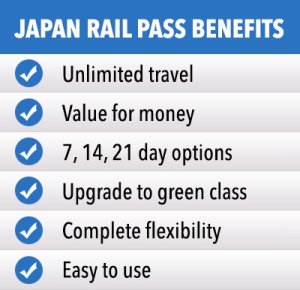7 Day Pass – Country Itinerary

The 7-day Japan Rail Pass gives you unlimited use of most Shinkansen and JR trains around Japan. If you need help coming up with an itinerary that makes the Pass all worth it, here is a sample:
Day 1: Narita Airport to Tokyo
The most convenient way of getting to Tokyo from Narita Airport is via the Narita Express. Upon arriving at Narita Airport, exchange your Japan Rail Pass voucher at the JR East Travel Service offices found at Terminal 1 and Terminal 2 of the airport. Ask for the Pass to be activated on that day so that you can use it to board the JR Narita Express to Tokyo. The trip takes about 1 hour.
Day 2: Tokyo
The JR Yamanote Line, which is fully covered by the JR Pass, provides easy access to many of Tokyo’s most popular attractions. It passes through various tourist districts, such as Shibuya (Hachiko Statue and Shibuya Crossing), Harajuku (Meiji Shrine), Shinjuku (Kabukicho, Golden Gai, Tokyo Metropolitan Government Office, Shinjuku Gyoen and Japanese Sword Museum), Ikebukuro (J-World and Namja Town), Ueno (Ueno Park) and Akihabara (Akihabara Electric Town), so you can plan your sightseeing according to its stops.

Metropolitan Government Building.

Cosplay woman in Harajuku park
Day 3: Tokyo to Nikko
Using you JR Pass, from Tokyo Station take a Shinkansen to Utsunomiya Station, where you need to transfer to the JR Nikko Line to reach Nikko. The one-way trip takes about 2 hours.
In central Nikko you can find the famous Toshogu Shrine, which is home to the mausoleum of the powerful Tokugawa Leyasu, the founder of the Tokugawa Shogun. In Nikko you can also visit the Taiyuinbyo, which is the mausoleum of the third Tokugawa Shogun, grandson of Leyasu, Lemitsu; the Futarasan Shrine, an ancient Buddhist Shrine; and the Rinnoji Temple, the city’s most important temple.

Day 4: Nikko to Takayama
Travelling from Nikko to Takayama involves a few train transfers and takes about 4.5 hours. Using your JR Pass, depart Nikko early in the morning and board the JR Nikko line to Utsunomiya, where you must transfer to a Shinkansen to Omiya. Then take a Shinkansen to Toyama and transfer to a Limited Express (Wide View) Hida train to finally arrive in Takayama.
Takayama boasts of a well-preserved Old Town, an open air museum known as the Hida Folk Village, the Takayama Jinya, morning markets and the Higashiyama Walk, which offers temples and other historical sites along the way.

Shinkyo Bridge – Nikko

Winter in Takayama
Day 5: Takayama – Day trip to Shirakawago
The beautiful and scenic Shirakawago is only about a 1-hour bus ride from Takayama (not covered by JR Pass; round trip costs 4,420 yen), so doing it as a day trip is feasible. Shirakawago is a UNESCO World Heritage Site best known for its farmhouses in the traditional gassho-zukiri architectural style.
Day 6: Takayama to Hakone
Known for its amazing views of Mt Fuji and its hot springs, Hakone is another side trip that can be done before heading back to Tokyo.
From Takayama Station, take the Limited Express (Wide View) Hida train to Nagoya, then transfer to a Shinkansen going to Odawara. This part of the journey takes about 4 hours and is fully covered by the JR Pass.
At Odawara Station, purchase a Hakone Free Pass (2-day pass costs 4,000 yen) for unlimited rides on all buses, cable cars, trains, ropeways and boats affiliated with Odakyu Railways in Hakone. With it, you can explore as much of the area as you want, including the Hakone Shrine, Hakone Hot Springs, Open Air Museum, Odawara Castle and Owakudani.

Hakone Hot Spring – ©JNTO

Mountain Fuji and Lake Ashi – Hakone
Day 7: Hakone to Tokyo
You can use the 2-day Hakone Free Pass to travel back to Odawara Station. From there, use your JR Pass to board a JR Tokaido Line train to Tokyo. The entire one-way travel takes about 2 hours.












